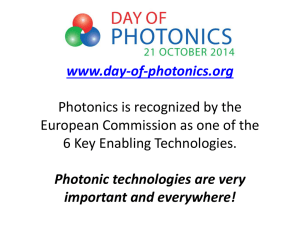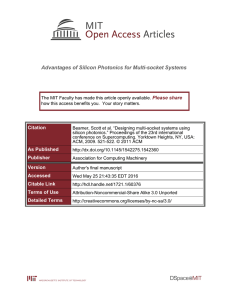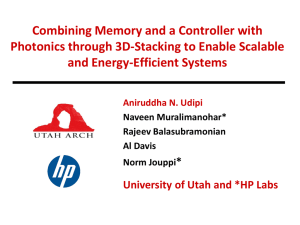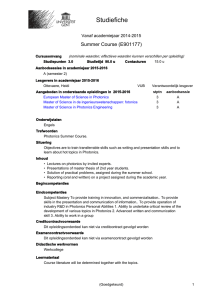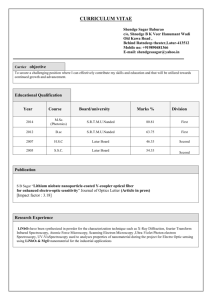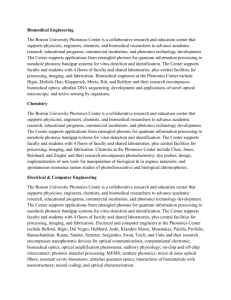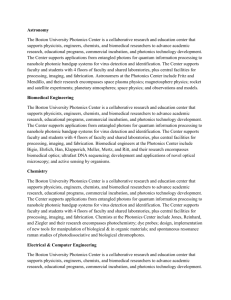Photonics7810_Apr2010
advertisement
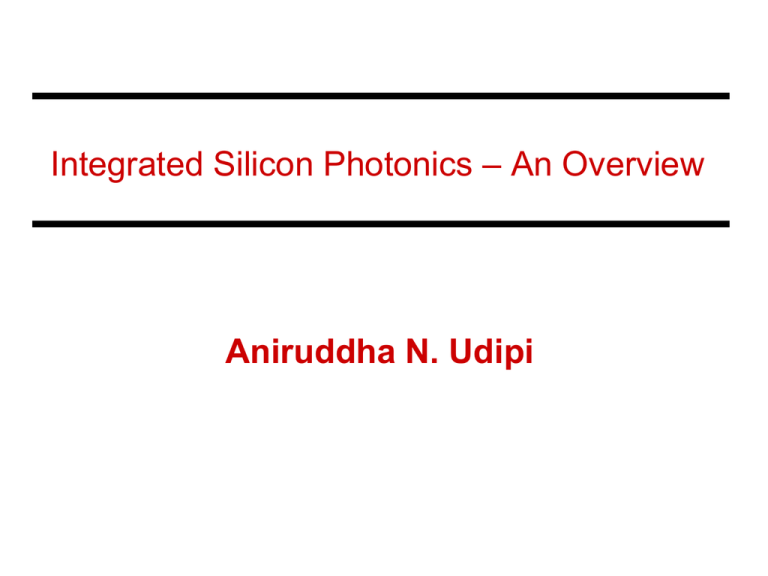
Integrated Silicon Photonics – An Overview Aniruddha N. Udipi What’s wrong with electrical signaling? • Power and delay fundamentally increase with length – Repeaters can help with delay, but further increase power – cannot afford this • Signal integrity issues – Limits on the number of “drops” (DIMMs, say) – Long, fast, wide – pick any two • Very slow growth of pin count and per pin bandwidth – Chip-edge and socket-edge bandwidth severely limited – Increasing pressure due to increasing communication requirements with multi-thread, multi-core, multi-socket • We need a disruptive new technology 2 Say Hello to Silicon Photonics • Simply put, replace wires and electrons with waveguides and photons • Advantages – Lower energy consumption, distance independent – Higher bandwidth, Dense Wavelength Division Multiplexing (DWDM) – Better scalability, no pin limits – In some cases, you simply cannot use electrical connections to satisfy the projected requirements • Where? – Started with large distances (Atlantic ocean large) – Increased viability over smaller distances as technology improves and matures – Next, interconnect inside datacenters - between racks – Eventually, intra-rack, intra-board, intra-chip… 3 Photonic Interconnect Basics Laser Channel Detector Modulator 0 1 0 1 0 0 0 1 1 1 0 1 Design Space – Laser, modulation, channel, detection 1 0 1 1 1 0 0 0 1 0 1 0 4 Photonic Components On-chip Laser • Vertical Cavity Surface Emitting Laser (VCSEL) – One of the largest volume (and hence, cheapest) lasers currently in use – Is often integrated on-chip – Enables “direct modulation” • You directly turn the laser on or off in accordance with the data being transmitted – Not fully CMOS compatible – Also, does not support DWDM 6 Off-chip Laser • Distinct component, actual construction not important • A single laser source can feed multiple channels – You just have a power splitter with the laser – Potential to be cost-effective in systems with multiple transmission channels (multiple memory channels, say) • Needs “external modulation” – Laser is on continuously, but you either block the light or not, depending on the data being transmitted • Supports DWDM • Under active consideration 7 Modulator Courtesy: D. Fattal and R. Beausoleil, HP Labs output Waveguide output input “OFF” STATE input “ON” STATE 8 Modulator Operation • How do you go between “ON” and “OFF”? – Charge injection (HP Labs) – Charge depletion (Sun) • These rings can be made “wavelength selective” with proper sizing during fabrication • There are also “disc” modulators; similar operational principle, only the physical implementation is different Courtesy: Xu et al. Optical Express 16(6), 4309–4315 (2008) 9 Channel • Silicon waveguide – Used on-chip – Moderate loss, crossover issues • Hollow metal waveguide – Used for slightly longer distances, at the board level – Low loss, ease of fabrication • Free space – Just use air! – Bunch of micro-mirrors and micro-lenses guide the light around – On-chip use • Fiber optic cable – Off-chip interconnect 10 Miscellaneous Components • Power splitters – Y splitter – divides the total power among several channels – 1:2, 1:4, and 1:8 splitters available – Other than drop in strength, signal is unaffected • Detectors – Seem to be simple photodetectors, I haven’t seen much variation or focus on this component • Power guides – Mux/Demux • Couplers Courtesy: Beamer et al. ISCA 2010 11 Features / Design Considerations Dense Wavelength Division Multiplexing • One of the primary advantages of photonics: excellent bandwidth density • Each wavelength of light transmits one bit, supported by a bunch of “wavelength selective” ring resonators – Each wavelength can operate independently • Total number of supported wavelengths limited by increasing coupling losses between rings as spacing is tightened • Up to 67 wavelengths theoretically possible • Each wavelength can run at ~10Gbps, giving a total of 80 GB/s of bandwidth per channel 13 Laser Power Considerations • The detectors need to receive some minimum amount of photonic power in order to reliably determine 0/1 – Depends on their “sensitivity” • Going from source to destination, there are several points of power loss – the waveguide, the rings, splitters, couplers, etc. • Work backwards to determine total input laser power required • Also some concerns about “non-linearity”, when total path loss exceeds a certain amount – Rule of thumb ~20dB 14 Static Power Considerations • Modulating rings are sized at fabrication time to be tuned to a particular wavelength • However, this tends to drift during operation • Not only will this hurt this specific wavelength, but may also drift into adjacent wavelengths in DWDM systems, causing interference • This drift can be controlled by heating, called “trimming” • These heaters consume non-trivial amounts of power • Large static power, cannot under-utilize or leave idle 15 Applications My personal research focus • Application to the processor-memory interface – Ideal candidate in many respects • Scalability, bandwidth, energy • The questions we’re trying to answer: – how can we best apply photonics to the memory subsystem? – Should we replace all interconnects with photonics? – what would the role of electrical signaling be? – how invasive would the required memory (DRAM) modifications be? • Off-chip laser, external ring-based modulation, off-chip fiber and on-chip silicon waveguides 17 Interconnects in the Memory system DRAM I/O – Processor Off-chip Interconnect DRAM Array – I/O On-chip Interconnect 18 Photonics vs. electronics • Photonics – Lower dynamic energy – Higher static energy – Cannot be over-provisioned or left idle – Perfect for the shared off-chip interconnect, helps break the pin barrier • Electronics – Higher dynamic energy – Lower static energy – Can be over-provisioned or left idle 19 Photonic Energy Electrical Energy How deep should photonics go on die? 20 Single-die system (Prior work) Argues for specialized memory dies with photonics deep inside – in this case, one stop for each quarter of the chip 21 But.. • Realistic systems cannot have a single die per channel • You simply need more capacity – 3D stacking – Daisy-chaining of these 3D stacks • Many more rings • The effect of photonics’ static energy much more pronounced • Argues for reducing photonic use • How? 22 Proposed design 23 Proposed Design • Introduce a 3D Stacked “Interface Die” • This die contains all photonic components • All further traversal is electrical – TSVs to move between dies vertically – Efficient low-swing wires on-die • Helps break the pin-barrier • Uses photonics on the heavily used shared off-chip interconnect, amortizes static energy • Uses electrical signaling locally, where activity is low 24 An analogy Can you really run the METRO to every house? 25 Realistic System Use a single stop per stack, on the interface die 26 Advantages of the proposed system • Energy consumption – Fewer photonic resources, without loss in performance – Rings, couplers, trimming • Industry considerations – Does not affect design of commodity memory dies – Same memory die can be used with both photonic and electrical systems – Same interface die can be used with different kinds of memory dies – DRAM, PCM, STT-RAM, Memristors 27 Final System • Compared to the best fullyoptical extension of the stateof-the-art photonic DRAM design – 23% reduced energy consumption – 4X capacity per channel – Potential for performance improvements due to increased bank count – Non-disruptive to commodity memory design 28 High-radix Datacenter Routers (HP Labs) 29 Simplify! • Need high dimension network to reduce hop count • Bandwidth per port has to scale over time • Photonics are perfect.. – Switch size unconstrained by device IO limits – Port bandwidth scalable by increasing number of wavelengths – Optical link ports can directly connect to anywhere within the data centre – Greatly increased connector density, reduced cable bulk – 64-128 DWDM port router possible 30 Macro-chips (Sun Labs, Oracle) • Die sizes are limited by process yield • For a given compute power requirement, therefore, you need several smaller chips • Large bandwidth requirement between these chips • With photonics, such a macro-chip design can approach a large chip performance 31 On-chip Interconnect (Rochester) 32 Ok, but when will all of this see light of day? • Adoption will be gradual, over smaller distances – – – – – km scale – it’s already happened – Under-sea cables 100m scale – in progress m scale – just starting cm scale – in the lab but relatively ready mm scale – also in the lab but not ready for prime time • Technology exists, constantly being improved by smart people in labs all over the world • Maturity, manufacturing infrastructure and cost are the big barriers – Catch 22! • First products expected in ~1year (Intel Light Peak) – USB replacement – Optical backplane for server racks ~2 years – Fancier applications will likely take ~5-8 years 33

